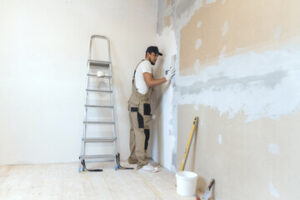There are several ways to repair small holes, dents, and dings in drywall. These repairs are easy and inexpensive. Drywall Repair Las Vegas typically involves sanding the hole and filling it with spackle. Then, please wait for the spackle to dry before painting it.
 Drywall tape creates a physical bond between adjacent drywall sheets, reducing movement and cracking. It’s an excellent choice for do-it-yourself drywall repair but also important for professional drywall contractors. There are two types of drywall taping: paper and fiberglass mesh. Each type is ideal for different jobs and skill levels.
Drywall tape creates a physical bond between adjacent drywall sheets, reducing movement and cracking. It’s an excellent choice for do-it-yourself drywall repair but also important for professional drywall contractors. There are two types of drywall taping: paper and fiberglass mesh. Each type is ideal for different jobs and skill levels.
Mesh tape is more durable than paper but may crack over time due to expansion and contraction in the drywall sheet. It can also be harder to work with, requiring more careful application and special tools. Paper drywall tape is easier to apply, and it does not leave behind residue. However, it is less versatile and more expensive than mesh tape.
Joint compound is a white powder made of gypsum dust mixed with water. It is used to finish gypsum panel joints, corner bread, trim, and fasteners, as well as patch holes and tears. It is sold pre-mixed in tubs and is usually a good choice when making minor repairs to plaster or sheetrock. It has a gooey paste-like consistency and is intended to fill small dings and dents, like nail holes.
It dries more quickly with less shrinkage than joint compound–meaning you can sand and paint over it more quickly. However, it is more expensive and generally only intended for small repair jobs. Joint tape is used for drywall repair to make a strong bond between drywall sheets. It is also used to patch holes in drywall.
To use joint tape, first apply a layer of joint compound to the seams between the panels of drywall. Next, place a strip of paper drywall tape over the wet mud, pushing it in every foot or so to hold it in place.
If any of the mud comes out from under the tape, feather it away to give a smooth surface. For best results, use a 10-inch drywall taping knife. The wide blade will feather the mud over all sides of the tape while still maintaining a smooth, uniform finish.
Sandpaper is a type of abrasive used for many DIY jobs, including sanding drywall. It comes in a variety of grit sizes and is made from natural or synthetic abrasives such as garnet, silicon carbide or aluminum oxide.
The grit of sandpaper is determined by the size of the abrasive grains embedded in it. These grains are sifted through screens and sorted by size before being bonded with adhesive to a paper, sponge or cloth-type backing.
When sanding drywall, start with 100-grit sandpaper to take off rough buildup. If your joint compound is smooth, you can go up to 120-grit for a more even finish.
The interiors of many homes and buildings are covered with gypsum wallboard, commonly called drywall. This smooth, flat surface can easily be damaged by everyday wear and tear.
Fortunately, these surfaces can be repaired without much effort with the use of a few basic tools and materials. The most basic repair is using quick-drying spackle or a drywall patch kit to fill small holes, dents, and gouges in the surface.
Once this is done, you need to sand the spackling or patching compound to make it as flat as possible. This will help to create an even surface that is easy to paint over once the spackling has dried.
You may need to repaint the entire wall if the repair is more extensive, such as a large hole or several patches. This is because the color of the patched area may stand out if it is not properly painted to blend in with the rest of the wall.
Drywall repair is the process of fixing damage to drywall surfaces, such as walls and ceilings, caused by holes, cracks, dents, or water damage. Drywall, also known as gypsum board or plasterboard, is a commonly used material for interior walls and ceilings in residential and commercial buildings.
Drywall repair typically involves cutting out the damaged section of drywall and replacing it with a new piece. This may involve taping and mudding the seams to create a seamless finish, sanding the surface, and applying a coat of paint to match the surrounding area.
Drywall repair may also involve fixing issues with the underlying structure, such as fixing damaged studs or adding extra support to the area to prevent future damage.